使用angular进行开发时,避免不了需要接触生命周期,下面本篇文章就来带大家一起聊聊angular中的生命周期,希望对大家有所帮助!

接触过 react 和 vue 开发的读者应该对生命周期这个概念不陌生。我们在使用 angular 开发的过程中,是避免不了的。【相关教程推荐:《angular教程》】
组件从开始建立到销毁的过程中,会经历过一系列的阶段。这就是一个生命周期,这些阶段对应着应用提供的 lifecycle hooks。
那么,在 angular 中,这些 hooks 都有哪些呢?了解它们,对你编写程序应该在哪里编写,很重要。
angular 中,生命周期执行的顺序如下:
- constructor 【常用,不算钩子函数,但是很重要】 - ngOnChanges【常用】 - ngOnInit【常用】 - ngDoCheck - ngAfterContentInit - ngAfterContentChecked - ngAfterViewInit【常用】 - ngAfterViewChecked - ngOnDestroy【常用】
为了解说和验证,我们用 angular-cli 生成一个 demo 项目。
在 es6 中的 class 初始化对象的时候,constructor 会立即被调用。
class Person {
constructor(name) {
console.log('be called')
this.name = name;
}
}
let jimmy = new Person('jimmy'); // be calledangular 的组件本身就是导出一个类。当这个组件被 new 起来的时候,会获取 constructor 中的预设的值。
当我们有外部参数更改的时候,我们就会执行 ngOnChanges,也就是说组件中有 @Input 所绑定的属性值发生改变的时候调用。
简单说,父组件绑定子组件中的元素,会触发这个钩子函数,可以多次出发。这在下面的 ngOnInit 总会介绍。
这个方法调用的时候,说明组件已经初始化成功。在第一次 ngOnChanges() 完成之后调用,且只调用一次。
// app.component.ts
export class AppComponent implements OnInit, OnChanges {
constructor() {
console.log('1. constructor')
}
ngOnChanges() {
console.log('2. ngOnChanges')
}
ngOnInit() {
console.log('3. ngOnInit')
}
}打印的信息如下:

咦?怎么没有打印 ngOnChanges 中的钩子函数信息呢?
上面已经说过了,需要触发条件 @Input 的属性值改变的时候。我们来修改一下:
<!-- app.component.html --> <div> <app-demo></app-demo> </div>
// app.component.ts // AppComponent 类中添加属性 public count:number = 0;
<!-- demo.component.html -->
<h3>count: {{ count }}</h3>// demo.component.ts
export class DemoComponent implements OnInit, OnChanges {
@Input()
public count: number;
constructor() {
console.log('1. demo constructor')
}
ngOnChanges() {
console.log('2. demo ngOnChanges')
}
ngOnInit() {
console.log('3. demo ngOnInit')
}
}
当通过 @Input 将值传递给子组件 demo 的时候,就会触发 demo 组件中的 ngOnChanges。
当 @Input 传递的属性发生改变的时候,可以多次触发 demo 组件中的 ngOnChanges 钩子函数。
<!-- app.component.html --> <div> <app-demo [count]="count"></app-demo> <button (click)="parentDemo()">parent button</button> </div>
// app.component.ts
parentDemo() {
this.count++;
}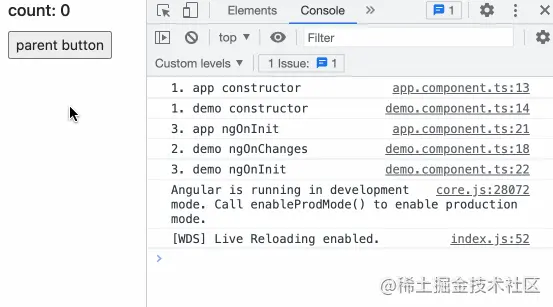
当发生变化检测的时候,触发该钩子函数。
这个钩子函数,紧跟在每次执行变更检测时候 ngOnChanges 和首次执行执行变更检测时 ngOnInit 后面调用。
// demo.component.ts
ngDoCheck() {
console.log('4. demo ngDoCheck')
}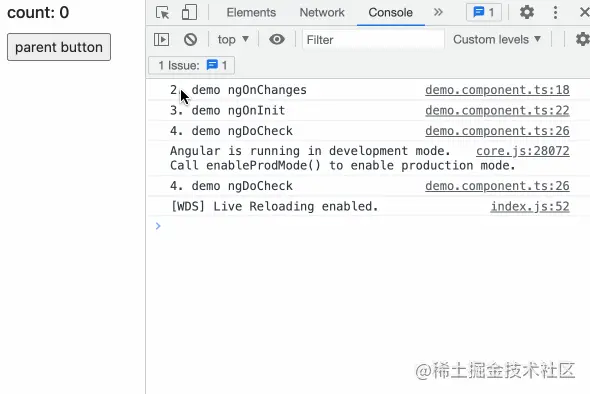
这个钩子函数调用得比较频繁,使用成本比较高,谨慎使用。
一般使用 ngOnChanges 来检测变动,而不是 ngDoCheck
当把外部的内容投影到内部组件,第一次调用 ngDoCheck 之后调用 ngAfterContentInit,而且只调用一次。
// demo.component.ts
ngAfterContentInit() {
console.log('5. demo ngAfterContentInit');
}
ngAfterContentChecked 钩子函数在每次 ngDoCheck 之后调用.
// demo.component.ts
ngAfterContentChecked() {
console.log('5. demo ngAfterContentChecked');
}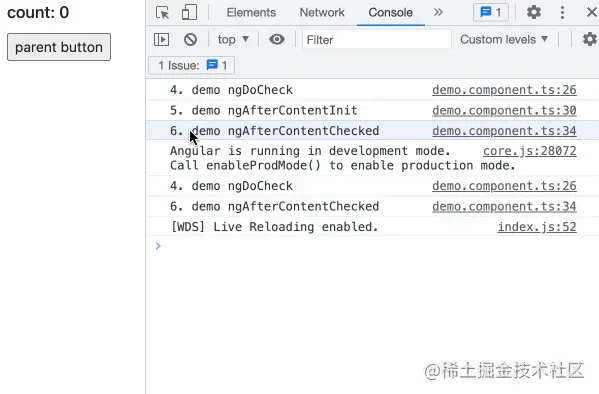
视图初始化完成调用此钩子函数。在第一次 ngAfterContentChecked 之后调用,只调用一次。
这个时候,获取页面的 DOM 节点比较合理
// demo.compoent.ts
ngAfterViewInit() {
console.log('7. demo ngAfterViewInit');
}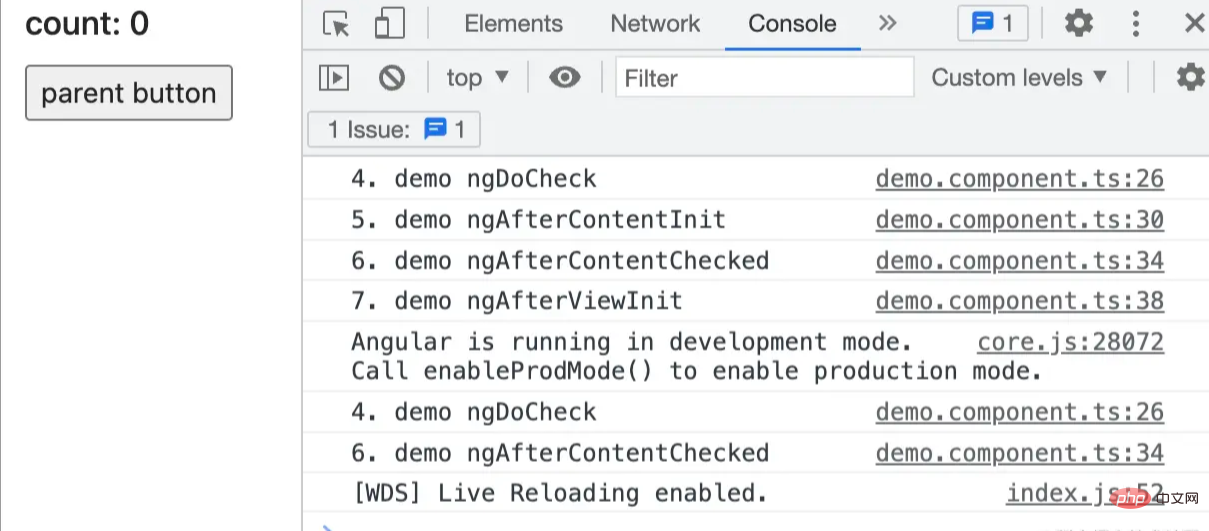
视图检测完成调用。在 ngAfterViewinit 后调用,和在每次 ngAfterContentChecked 之后调用,也就是在每次 ngDoCheck 之后调用。
// demo.component.ts
ngAfterViewChecked() {
console.log('8. ngAfterViewChecked')
}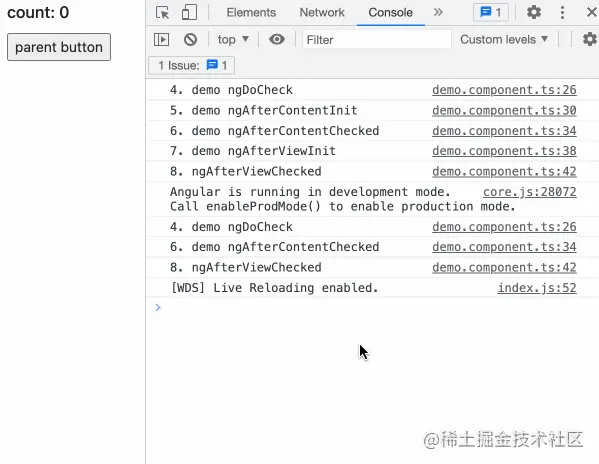
组件被销毁时候进行的操作。
在这个钩子函数中,我们可以取消订阅,取消定时操作等等。
<!-- app.component.html --> <app-demo [count]="count" *ngIf="showDemoComponent"></app-demo> <button (click)="hideDemo()">hide demo component</button>
// app.component.ts
public showDemoComponent: boolean = true;
hideDemo() {
this.showDemoComponent = false
}// demo.component.ts
ngOnDestroy() {
console.log('9. demo ngOnDestroy')
}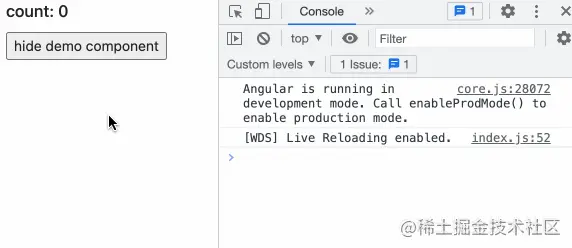
PS: 不知道读者有没有发现,调用一次的钩子函数都比较常用~
【完】
更多编程相关知识,请访问:编程入门!!
以上就是一文聊聊Angular中的生命周期的详细内容,更多请关注php中文网其它相关文章!

每个人都需要一台速度更快、更稳定的 PC。随着时间的推移,垃圾文件、旧注册表数据和不必要的后台进程会占用资源并降低性能。幸运的是,许多工具可以让 Windows 保持平稳运行。




Copyright 2014-2025 https://www.php.cn/ All Rights Reserved | php.cn | 湘ICP备2023035733号